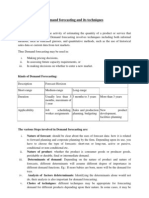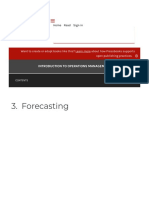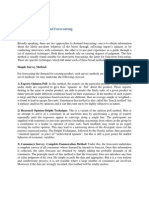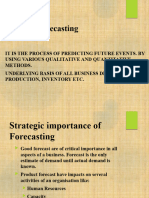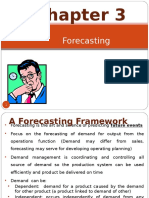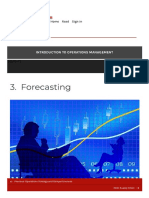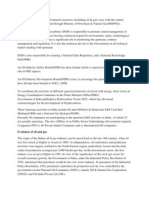Demand Forecasting: Determination of The Demand Forecasts Is Done Through The Following Steps
Uploaded by
Utkarsh KichluDemand Forecasting: Determination of The Demand Forecasts Is Done Through The Following Steps
Uploaded by
Utkarsh KichluDemand Forecasting
What is a demand forecast? A demand forecast is the prediction of what will happen to your company's existing product sales. It would be best to determine the demand forecast using a multi-functional approach. The inputs from sales and marketing, finance, and production should be considered. The final demand forecast is the consensus of all participating managers. You may also want to put up a Sales and Operations Planning group composed of representatives from the different departments that will be tasked to prepare the demand forecast. Determination of the demand forecasts is done through the following steps: Determine the use of the forecast Select the items to be forecast Determine the time horizon of the forecast Select the forecasting model(s) Gather the data Make the forecast Validate and implement results
The time horizon of the forecast is classified as follows: Description Short-range Duration Forecast Horizon Medium-range Long-range More than 3 years Usually less than 3 3 months to 3 years months, maximum of 1 year Job scheduling, worker assignments
Applicability
Sales and production New product planning, budgeting development, facilities planning
How is demand forecast determined? There are two approaches to determine demand forecast (1) the qualitative approach, (2) the quantitative approach. The comparison of these two approaches is shown below: Description Applicability Qualitative Approach Quantitative Approach
Used when situation is vague & Used when situation is stable & little data exist (e.g., new products historical data exist and technologies) (e.g. existing products, current technology) Involves intuition and experience Jury of executive opinion Sales force composite Delphi method Consumer market survey Involves mathematical techniques Time series models Causal models
Considerations Techniques
Qualitative Forecasting Methods
Your company may wish to try any of the qualitative forecasting methods below if you do not have historical data on your products' sales. Qualitative Method Jury of executive opinion Description The opinions of a small group of high-level managers are pooled and together they estimate demand. The group uses their managerial experience, and in some cases, combines the results of statistical models. Each salesperson (for example for a territorial coverage) is asked to project their sales. Since the salesperson is the one closest to the marketplace, he has the capacity to know what the customer wants. These projections are then combined at the municipal, provincial and regional levels. A panel of experts is identified where an expert could be a decision maker, an ordinary employee, or an industry expert. Each of them will be asked individually for their estimate of the demand. An iterative process is conducted until the experts have reached a consensus.
Sales force composite
Delphi method
Consumer market survey
The customers are asked about their purchasing plans and their projected buying behavior. A large number of respondents is needed here to be able to generalize certain results.
Quantitative Forecasting Methods There are two forecasting models here (1) the time series model and (2) the causal model. A time series is a s et of evenly spaced numerical data and is obtained by observing responses at regular time periods. In the time series model , the forecast is based only on past values and assumes that factors that influence the past, the present and the future sales of your products will continue. On the other hand, t he causal model uses a mathematical technique known as the regression analysis that relates a dependent variable (for example, demand) to an independent variable (for example, price, advertisement, etc.) in the form of a linear equation. The time series forecasting methods are described below:
Description Time Series Forecasting Method Nave Approach Assumes that demand in the next period is the same as demand in most recent period; demand pattern may not always be that stable For example: If July sales were 50, then Augusts sales will also be 50
Description Time Series Forecasting Method Moving Averages MA is a series of arithmetic means and is used if little or no trend is present in the data; provides an overall impression of data over time (MA) A simple moving average uses average demand for a fixed sequence of periods and is good for stable demand with no pronounced behavioral patterns. Equation:
F 4 = [D 1 + D2 + D3] / 4
F forecast, D Demand, No. Period (see illustrative example simple moving average) A weighted moving average adjusts the moving average method to reflect fluctuations more closely by assigning weights to the most recent data, meaning, that the older data is usually less important. The weights are based on intuition and lie between 0 and 1 for a total of 1.0 Equation: WMA 4 = (W) (D3) + (W) (D2) + (W) (D1) WMA Weighted moving average, W Weight, D Demand, No. Period (see illustrative example weighted moving average) Exponential Smoothing The exponential smoothing is an averaging method that reacts more strongly to recent changes in demand by assigning a smoothing constant to the most recent data more strongly; useful if recent changes in data are the results of actual change (e.g., seasonal pattern) instead of just random fluctuations
F t + 1 = a D t + (1 - a ) F t
Where F t + 1 = the forecast for the next period D t = actual demand in the present period F t = the previously determined forecast for the present period = a weighting factor referred to as the smoothing constant (see illustrative example exponential smoothing) Time Series Decomposition The time series decomposition adjusts the seasonality by multiplying the normal forecast by a seasonal factor (see illustrative example time series decomposition)
You might also like
- Demand Forecast Process and Inventory ManagementNo ratings yetDemand Forecast Process and Inventory Management17 pages
- Forecasting: Submitted By: Bindu Thushara. N Igtc Date: October 02, 2013100% (1)Forecasting: Submitted By: Bindu Thushara. N Igtc Date: October 02, 201328 pages
- Forecasting - Introduction To Operations ManagementNo ratings yetForecasting - Introduction To Operations Management24 pages
- Production and Project Management Cheg5211 Sales ForecastingNo ratings yetProduction and Project Management Cheg5211 Sales Forecasting31 pages
- MPD412 - Ind Org - Lecture-02-Forecasting - Part ANo ratings yetMPD412 - Ind Org - Lecture-02-Forecasting - Part A26 pages
- Estimating and Forecasting Demand: What Is A Demand?No ratings yetEstimating and Forecasting Demand: What Is A Demand?6 pages
- Lessons in Business Statistics Prepared by P.K. ViswanathanNo ratings yetLessons in Business Statistics Prepared by P.K. Viswanathan52 pages
- MM ZG 523 / QMJ ZG 523 Project ManagementNo ratings yetMM ZG 523 / QMJ ZG 523 Project Management63 pages
- What Do You Mean by Demand Forecasting? What Are Its Various Types?No ratings yetWhat Do You Mean by Demand Forecasting? What Are Its Various Types?4 pages
- Forecasting: Submitted By: Bindu Thushara. N Igtc Date: October 02, 2013Forecasting: Submitted By: Bindu Thushara. N Igtc Date: October 02, 2013
- Forecasting - Introduction To Operations ManagementForecasting - Introduction To Operations Management
- Production and Project Management Cheg5211 Sales ForecastingProduction and Project Management Cheg5211 Sales Forecasting
- MPD412 - Ind Org - Lecture-02-Forecasting - Part AMPD412 - Ind Org - Lecture-02-Forecasting - Part A
- Estimating and Forecasting Demand: What Is A Demand?Estimating and Forecasting Demand: What Is A Demand?
- Lessons in Business Statistics Prepared by P.K. ViswanathanLessons in Business Statistics Prepared by P.K. Viswanathan
- What Do You Mean by Demand Forecasting? What Are Its Various Types?What Do You Mean by Demand Forecasting? What Are Its Various Types?
- Thesis On Use of Vectors in Financial GraphsFrom EverandThesis On Use of Vectors in Financial Graphs


